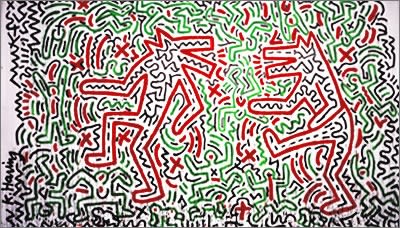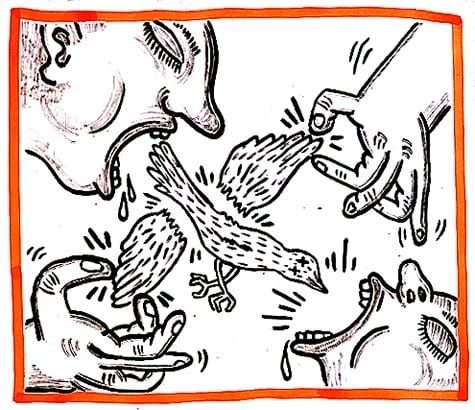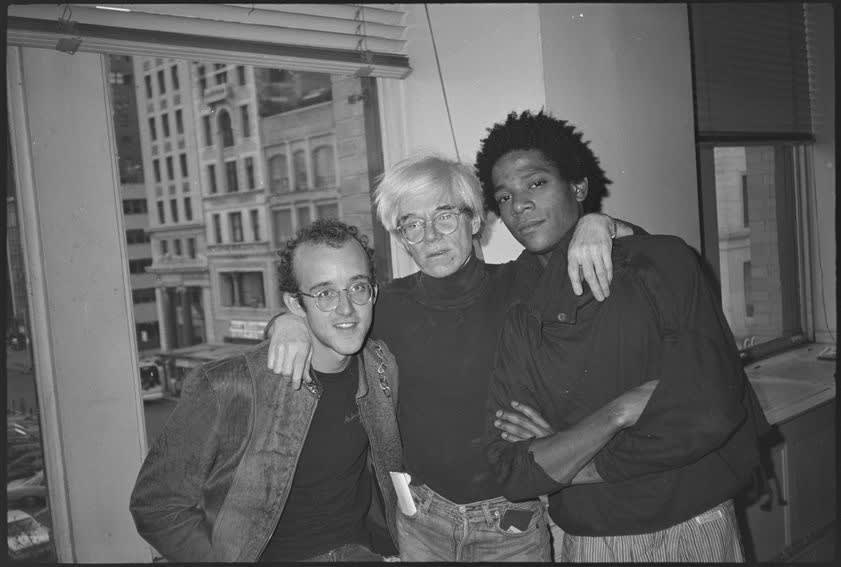It was last summer when Rhodes displayed the collection of works and artifacts of artist Keith Haring. Now we are revisiting the life and artistic career of Philadelphia born artist and activist who worked in New York during 1980s. The legacy of Keith Haring continues strongly into the present day.
Keith Haring’s work represents a recognisable 20th century visual language, based on a graphic style which used a thick line and symbols of Man-Dog’s, flying saucers, Mickey Mouse and a radiating baby.
Haring used art as a creative expression and a tool to talk about social issues. His work addressed many important social issues in the 1980’s including AIDS, apartheid, drug addiction and LGBTQ rights. He wanted his artwork to be accessible to the public, and created public murals in a universally recognisable language. In the early 1980s he was inspired by the graffiti and urban art scene and experimented on the New York Subway by drawing these energetic and expressive directly on empty advertising spaces at fast pace. The black paper served as a perfect canvas for his white graffiti chalk drawings. He saw these artistic experiments as performances, in which the interactions from the public were also an equally interesting effect. By 1983, Haring had developed a unique visual language and was gaining huge attention from his Subway murals.
Haring was always interested in the public and the accessibility of his message. Today you can find Keith Haring pins, caps, t-shirts, and skateboards.The Pop Shop was set up in downtown New York which sold his artwork commercially at affordable prices. The atmosphere of the shop was fun and club-like, with music playing, the walls covered in his murals. His work had huge commercial success, they were popular, entertaining and appealed to a range of people. When he was an art student, Haring was cynical about the art world, preferring to bring art straight to the people stating: “The public has a right to art/The public is being ignored by most contemporary artists/Art is for everybody.”
His iconic cartoon-like works are imbued with social and political messages; he wanted to raise public consciousness about certain issues including politics and safe sex. His public murals are joyous and accessible, and were often collaborative projects with the community; the two Tama City murals in Tokyo were created with 500 children.
He was introduced to many musicians and artists in the New York 1980s club-scene, hanging out with Yoko Ono, David Bowie, Iggy Pop and William Burroughs. Following his second exhibition at the Tony Shafrazi Gallery in 1984, Haring met Andy Warhol who became a life long mentor, even making a series ‘Andy Mouse’, which combined Warhol and his other inspiration Walt Disney. A crew with Haring, Scharf and Jean-Michel Basquiat also emerged which shook up the established art world as they started creating art about low culture, rap and pop music. Due to the subject matter and the commercial appeal of his work, Haring was not taken seriously by the elitist art institutions.
Haring was diagnosed with the AIDS disease- something he was publicly honest about and set up the Keith Haring Foundation which supports disadvantaged children and AIDs charities to this day. He died of an AID-related illness at the age of 31 in 1990.
The enduring legacy of Keith Haring continues, with his work in various collections across the world. Many of his murals have been conserved and are still around today and his works remains in public galleries such as the Whitney and MoMa. Tate Liverpool opened a retrospective of Keith Haring’s work in 2019, the show included 85 artworks including large, vibrant paintings and drawings, as well as posters, photographs, and videos that capture the vibrancy of 1980s New York street culture. Rhodes Contemporary coincided this show with ‘ICON’, a collection and celebration of Haring’s works.
If you are looking to sell or buy any Keith Haring works, please get in touch with the gallery. You can contact us by email info@rhodescontemporaryart.com.




